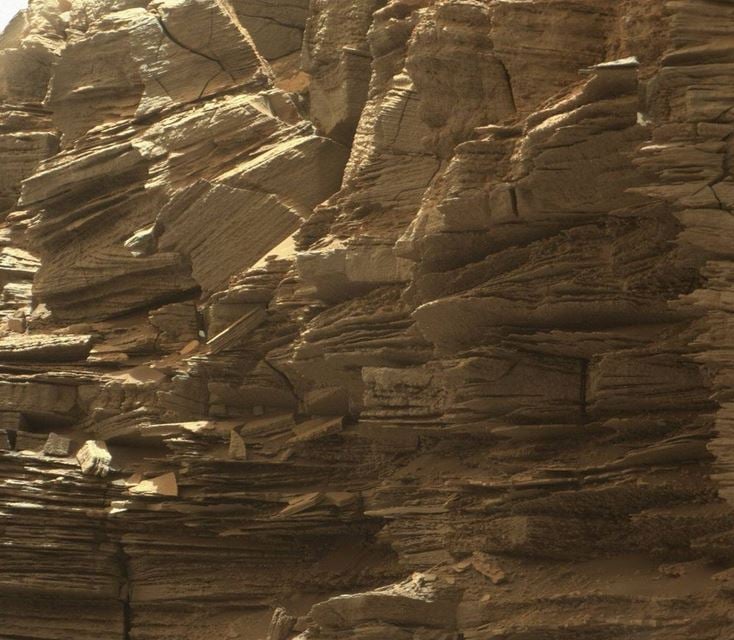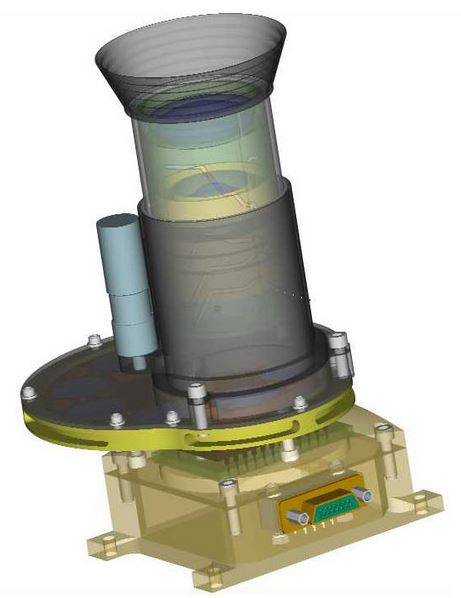Images of striking rock formations have been sent back to Earth from NASA’s Curiosity Mars rover. Scientists say the colour photographs will help increase their understanding of the Red Planet’s landscape.
The images, which were taken on Thursday, are of the ‘Murray Buttes’ region of lower Mount Sharp, a spectacular mountain with an altitude of 18,000 feet, where Curiosity has been based for the past two years.
Curiosity took the photographs with its Mastcam (Mast Camera). These new images represent the vehicle’s last stop at Murray Buttes, where it has been exploring for over one month.
 This view from Curiosity’s Mastcam shows a sloping hillside within the ‘Murray Buttes’ region on lower Mount Sharp. The rim of Gale Crater is visible in the distance through the dusty haze. (Image: mars.nasa.gov)
This view from Curiosity’s Mastcam shows a sloping hillside within the ‘Murray Buttes’ region on lower Mount Sharp. The rim of Gale Crater is visible in the distance through the dusty haze. (Image: mars.nasa.gov)
Curiosity studying Mars evolution
Part of Curiosity Mars’ mission is to look into how and when habitable conditions on the Red Planet that were present a long time ago evolved into much drier conditions that are less favourable for life on the planet.
Curiosity scientist, Dr. Ashwin Vasavada, who works at the Jet Propulsion Laboratory at the California Institute of Technology, said he and his team were ‘thrilled’ to undertake the expedition,, which they describe as ‘a bit of American desert Southwest on Mars.’
The striking rock formations we can see in the images are the remnants of ancient sandstone which were formed when sands were deposited by the winds on the lower regions of the mountain.
Ancient lakes billions of years ago
The Mars Curiosity Rover landed near Mount Sharp in 2012. Two years later, it reached the base of the mountain after successfully finding evidence of ancient Martian lakes on the surrounding plains. When the lakes existed, conditions were probably favourable for microbes to thrive.
 The mesas and buttes rising above the surface in this area are eroded remnants of ancient sandstone that originated when sand was deposited by wind after the formation of lower Mount Sharp. (Image: mars.nasa.gov)
The mesas and buttes rising above the surface in this area are eroded remnants of ancient sandstone that originated when sand was deposited by wind after the formation of lower Mount Sharp. (Image: mars.nasa.gov)
The rock layers, which formed at the base of the mountain, accumulated as sediment within these ancient lakes billions of years ago.
Regarding the close-up images of the buttes, Dr. Vasavada said:
“Studying these buttes up close has given us a better understanding of ancient sand dunes that formed and were buried, chemically changed by groundwater, exhumed and eroded to form the landscape that we see today.”
Curiosity has now left the buttes and is continuing on its journey higher up Mountain Sharp.
NASA scientists say they plan to create a number of mosaics from these pictures, which they say are eerily similar to images taken in American national parks.
 Curiosity got very close to this outcrop within the ‘Murray Buttes’ on 9th September, which displays finely layered rocks. The layering within the sandstone is called ‘cross-bedding’ and suggests that the sandstone was deposited by wind as migrating sand dunes. (Image: mars.nasa.gov)
Curiosity got very close to this outcrop within the ‘Murray Buttes’ on 9th September, which displays finely layered rocks. The layering within the sandstone is called ‘cross-bedding’ and suggests that the sandstone was deposited by wind as migrating sand dunes. (Image: mars.nasa.gov)
Curiosity rover
NASA’s Mars Curiosity rover is a car-sized robotic vehicle that is exploring the Gale Crater on Mars. It forms part of NASA’s Mars Science Laboratory Mission. The rover has been on the Red Planet for 1,457 sols (1,496 Earth days) since landing on 6th August, 2012.
Best. Road trip. Ever. Feast your eyes on the Martian landscape. https://t.co/7FCAmM1EgY #JourneytoMars pic.twitter.com/UaQvyoSOSU
— Curiosity Rover (@MarsCuriosity) 9 September 2016
Curiosity has the following goals:
– investigate Mars’ climate and geology
– assess whether the selected field site inside Gale Crater was ever suitable for microbial life to exist
– determine how much water there was (is) in the region
– study the planet in preparation for future human exploration
The rover’s mission was originally planned for just two years. In December 2012, its mission was extended indefinitely.
 The MastCam (mast camera) has been capturing the Martian terrain in colour photos and high-definition video. (Image: mars.nasa.gov. Credit: NASA/JPL-Caltech/MSSS)
The MastCam (mast camera) has been capturing the Martian terrain in colour photos and high-definition video. (Image: mars.nasa.gov. Credit: NASA/JPL-Caltech/MSSS)
The robot has a mass of 899 kg (1,982 lb), including eighty kilograms (180 lb) of scientific instruments. The MastCam system provides multiple spectra and true-colour imaging with two cameras.
The two cameras take true-color photographs at 1600×1200 pixels and are capable of taking up to ten frames per second hardware-compressed video at 720p.
Video – View from Mars
Since arriving on the Red Planet in 2012, NASA’s Curiosity rover has traversed, analysed, drilled and zapped the Martian surface while providing us with new views of an ancient world.
